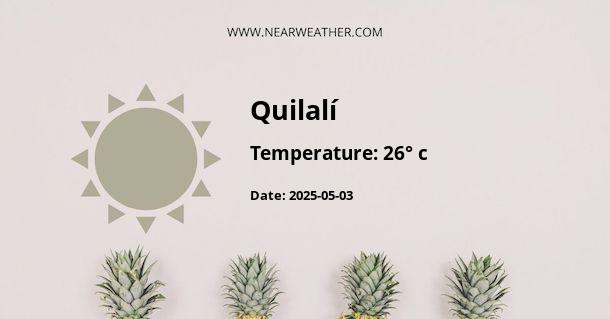Quilali, Nicaragua: A Comprehensive Guide to Its Climate and Weather Year Round
Nestled in the picturesque highlands of Nicaragua, Quilali is a charming town known for its breathtaking natural beauty and temperate climate. Understanding the weather patterns and climate variations of Quilali is essential for residents, travelers, and businesses. In this comprehensive guide, we will delve into the year-round weather conditions, climate characteristics, and seasonal variations in Quilali, Nicaragua.
Climate Overview
Quilali, like much of Nicaragua, experiences a tropical climate with distinct wet and dry seasons. The town's elevation in the northern highlands contributes to slightly cooler temperatures compared to the lowland regions. The climate is typically characterized by warm temperatures, moderate humidity, and well-defined rainy and dry periods.
Annual Temperature and Weather Patterns
The table below provides a summary of the average monthly temperatures and precipitation in Quilali, showcasing the distinct seasonal variations in the town's climate.
| Month | Average High (°C) | Average Low (°C) | Precipitation (mm) |
|---|---|---|---|
| January | 30 | 20 | 5 |
| February | 31 | 20 | 6 |
| March | 32 | 21 | 7 |
| April | 32 | 22 | 90 |
| May | 31 | 23 | 218 |
| June | 30 | 23 | 177 |
| July | 30 | 23 | 170 |
| August | 30 | 23 | 167 |
| September | 30 | 23 | 226 |
| October | 30 | 22 | 215 |
| November | 30 | 21 | 47 |
| December | 30 | 20 | 15 |
As depicted in the table, the dry season in Quilali spans from December to April, with significantly lower precipitation levels. The wet season runs from May to November, with the highest rainfall occurring in September and October. The town experiences a notable shift in temperature during these seasons, with April being the hottest month and August-November being the coolest months on average.
Microclimates and Local Variations
Due to its diverse topography, Quilali exhibits microclimates with variations in temperature, precipitation, and humidity. The surrounding mountains and valleys can influence local weather patterns, leading to differences in climate across the region. It's important for residents and visitors to be aware of these microclimatic variations when planning outdoor activities or agricultural endeavors.
Impact of Climate on Agriculture and Wildlife
The climate of Quilali plays a pivotal role in shaping the region's agricultural practices and supporting its rich biodiversity. The dry season allows for optimal conditions for cultivating crops such as coffee, maize, and beans, while the wet season contributes to lush vegetation and sustains diverse wildlife, including various bird species and mammals. Understanding the seasonal climate patterns is crucial for farmers and conservation efforts in Quilali.
Conclusion
In conclusion, Quilali, Nicaragua, boasts a tropical climate with distinct wet and dry seasons, influenced by its elevation and diverse topography. The town experiences warm temperatures year-round, with pronounced seasonal variations in precipitation. By understanding the climate and weather patterns of Quilali, residents, tourists, and businesses can make informed decisions and fully appreciate the natural splendor of this captivating region.
Whether it's planning agricultural activities, exploring the local flora and fauna, or simply embracing the outdoor lifestyle, Quilali's climate and weather year-round offer a rich tapestry of experiences for all who visit this enchanting town.
A - Quilalí's Latitude is 13.566950 & Longitude is -86.026001.
A - Weather in Quilalí is 26° today.
A - Climate Conditions in Quilalí shows scattered clouds today.
A - Humidity in Quilalí is 68% today.
A - Wind speed in Quilalí is 8.14 km/h, flowing at 75° wind direction. today.
